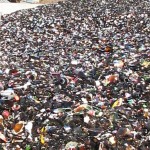Read Part 1 of this article here.
 Take an empty beer bottle. We can either throw that glass bottle away or recycle it.
Take an empty beer bottle. We can either throw that glass bottle away or recycle it.
Assume for a moment that we all want what’s best for the planet. Assume, therefore, that we want to use as few resources as possible.
Should we recycle our beer bottle, then? Or should we throw it away?
And how do we know?
Do we believe the Al Gore’s of the world, who assert what we should do, for no other reason than that they assert it? Or do we look into the actual data ourselves?
Ask yourself this:
If recycling is more expensive than using new materials, can it really be more efficient?
The free market prices its resources by what’s called opportunity cost.
Opportunity cost is not arbitrary.
It means that producers won’t choose packaging which costs more if that packaging is identical (or inferior) to other options.
For years now, many of you have spent thousands upon thousands upon thousands of hours sorting, washing, de-labeling, and resorting bottles so that these bottles could be recycled.
The horrible truth of the matter is that most of these hours have been a complete waste, the very thing you sought to avoid.
But more than that: the environment is worse off because of your efforts.
Most of the glass you’ve worked hard to have recycled is now resting in some landfill – via a very circuitous, and very costly, route.
That’s a fact.
Here are a few more:
Recycled glass is called cullet.
The process of producing cullet consists of grinding up glass, which in turn requires machines and much electricity.
Recycling glass is a thoroughly industrial process, make no mistake.
Cullet glass is full of additives, contaminants, and impurities, most of which are trapped within the cullet, so that they remain harmless. If, however, someone again melts the glass, which is precisely what happens when it is recycled, these contaminants are released into the earth, water, and air.
Different colored glasses cannot be merged for bottles.
Mixed cullet is, for the most part, useless.
Clear glass and green glass are usually landfilled.
Glass broken beyond a certain point is landfilled.
Amber glass is the only recyclable glass that’s remotely in demand.
Silica – also known as sand, which is what glass is made of – is exceptionally cheap and exceptionally abundant.
Silica production is not a danger to the environment, by any standard. Indeed, silica is made into glass without any extra steps or expense, unlike recycled glass, which is much more involved and much more environmentally unfriendly.
That is why virgin glass is cheaper than cullet glass. It also, incidentally, provides you with a critical clue into something you should know the next time you ponder whether to throw your bottles into the trash, or into the recycling bin.
If cullet glass is more expensive and also more toxic, and if cullet glass usually ends up in landfills anyway, why, then, do we bother recycling glass?
A good question, for which, unfortunately, there is no good answer.
Here, however, are some of the bad ones:
“Recycling is always cheaper, no matter how much it costs in terms of those Federal Reserve notes you call money,” say a number of my critics.
And:
“Silica mining rapes Mother Earth.”
You can certainly believe this nonsense if you like, and I, for one, will certainly never convince you otherwise, no matter the evidence.
But you should be aware of how much more waste you’re creating, and how much more you are polluting the environment.
You can also believe, as many never tire of telling me, that “recycling has a spiritual component,” which in turn gives recycled products “special value that price cannot measure.”
But I’m speaking to those of you who have not yet been blinded by the environmental dogma:
If price is a reliable indicator – and it is – then the majority of recycling is incontrovertibly irrational.
It is worth noting that many American cities, though explicitly “green,” have nevertheless come to see what for many of us has been blindingly obvious for years: glass recycling is an utter waste. It’s a waste of time, and it’s a waste of resources and money. Furthermore, it’s bad for the environment.
That is why many American cities have wisely done away with glass recycling – green glass in particular, which is so plentiful that it’s ridiculous to recycle it, and the cullet market for which is so overwhelmed by an excess supply that recycling it costs big time, in every way, because so much of it is ultimately landfilled.
There are, of course, a number of other cities that “have tried to delete green glass from the list of recyclable materials, but face a political veto from recycling enthusiasts. And, interestingly, the political opposition comes precisely from those people who will end up paying more for the inefficiency of the recycling they insist they want. Taxpayers, citizens, the folks who take their garbage out to the street, want to ask the city to put green glass back on the recyclable list, regardless of the cost” (Michael Munger, “Think Globally, Act Irrationally: Recycling”).
The Coors Recycling Plant is where all recyclable glass in the entire Colorado region goes. An employee there, who requested anonymity, told me this:
“A great deal of what has been sorted for recycling does end up being landfilled, despite what you hear, because of contamination or lack of market for the recycled material.”
How much?
“Don’t ask.”
One estimate: less than half.
Another estimate: less than a third.
Another: less than a quarter.
Conservatively, this means that if 80,000 tons are hauled for recycling, about 40,000 tons ends up in a landfill.
To put that into perspective:
Rather than throw your bottles into the trash and then pay one of our fine local haulers to take that trash to the dump, as we used to do in the good old days before the religion of environmentalism swept across the country like a plague, we are now paying our local government, in the form of subsidies, so that we can now spend thousands upon thousands of hours cleaning, de-labeling, sorting, and resorting glass, so that we can then pay for more trucks to pump more pollution into the air and use more fossil fuels in the process, so that finally our bottles can be hauled a couple of hundred miles (roundtrip), so that they can then, at last, be landfilled.
That is the beauty of green politics and all their profligate governmental bureaucracies.
That is our earth-friendly greens at their finest.
It is also sheer madness.
Ask yourself another question:
How has such a fraud been perpetrated?
Answer: the neo-Marxist philosophy of environmentalism and your tacit sanction of that philosophy.
Recycling “feels good,” for instance.
It has a “spiritual component.”
Recycling “simply must be better for the environment.”
Humans are a blight upon the earth.
Reader, you’re being lied to.
You’ve been brainwashed into believing that throwing away your Heinenken bottles will destroy the planet.
If you only hear a single thing that I’m saying, let it be this: if something is viable, it will never need to be subsidized.
If subsidies are called for, that thing is wrong.
Recycling must by necessity be subsidized because it is inherently wasteful. When recycling is not wasteful, it’s done voluntarily, as it’s been done since the dawn of humankind.
If you doubt this, read Rubbish, by one of our foremost rubbish experts, Doctor William Rathje.
And remember this also:
“There is a simple test for determining whether something is a resource (something valuable) or just garbage (something you want to dispose of at the lowest possible cost, including costs to the environment). If someone will pay you for the item, it’s a resource. Or, if you can use the item to make something else people want, and do it at lower price or higher quality than you could without that item, then the item is also a resource. But if you have to pay someone to take the item away, or if other things made with that item cost more or have lower quality, then the item is garbage” (Michael Munger, “Think Globally, Act Irrationally: Recycling”).
